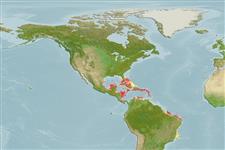Common names from other countries
Environment: milieu / climate zone / depth range / distribution range
экология
ассоциированный с рифами; солоноватоводный; пределы глубины 9 - 12 m (Ref. 108813). Tropical
Western Central Atlantic.
Length at first maturity / Size / Вес / Возраст
Maturity: Lm ? range ? - ? cm Max length : 50.0 cm TL самец/пол неопределен; (Ref. 415)
Laterally fused tubes running on branches (Ref. 81728): up to 50 cm long, 10 - 20 cm in diameter. Light to purplish brown externally, yellow to tan internally. The surface is smooth, with meandering groves occasionally. Oscules on the inner walls of the tubes few millimeters in diameter (Ref. 415).
Life cycle and mating behavior
половая зрелость | размножение | нерест | икра | Fecundity | личинки
Members of the class Demospongiae are hermaphroditic. Life cycle: The zygote develops into parenchymella larva (free-swimming) before settling down on a substrate where it grows into a young sponge.
Основная ссылка
ссылки | координатор | соавторы
Collin, R., M.C. Díaz, J. Norenburg, R.M. Rocha, J.A. Sánchez, M. Schulze, A. Schwartz and A. Valdés. 2005. (Ref. 415)
Статус Красного Списка МСОП (Ref. 130435: Version 2024-1)
Статус СИТЕС (Ref. 108899)
Not Evaluated
Not Evaluated
Угроза для людей
Harmless
Использование человеком
| FishSource |
инструменты
дополнительная информация
Возраст/РазмерыростЗависимость между длиной и массой телаЗависимость между длинамиморфологияличинкичисленность
ресурсы в Интернет
Estimates based on models
Preferred temperature
(Ref.
115969): 26.1 - 28.1, mean 27 (based on 188 cells).
Уязвимость
Moderate vulnerability (40 of 100).
Категория цены
Unknown.
